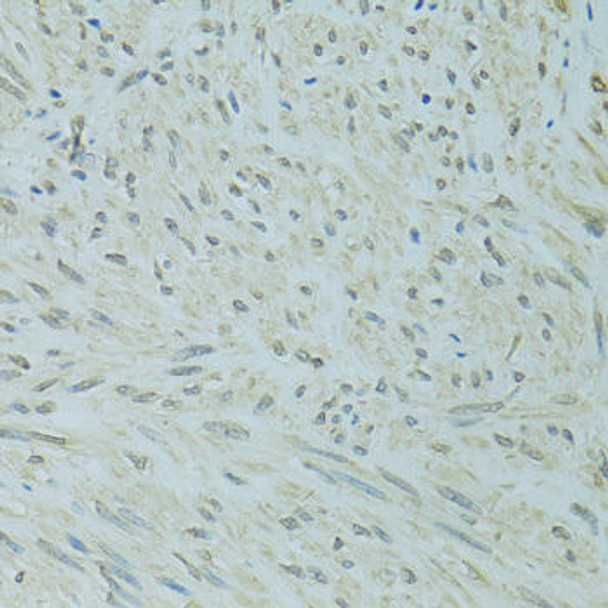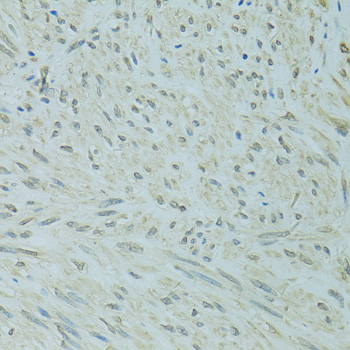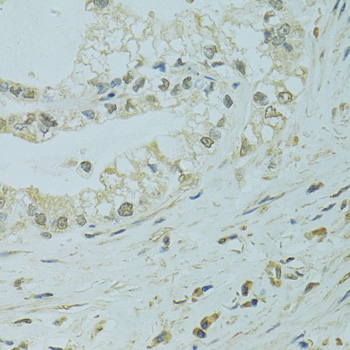Anti-XBP1 Antibody (CAB14860)
- SKU:
- CAB14860
- Product type:
- Antibody
- Reactivity:
- Human
- Reactivity:
- Mouse
- Host Species:
- Rabbit
- Isotype:
- IgG
- Antibody Type:
- Polyclonal Antibody
- Research Area:
- Cardiovascular
Description
| 抗体名: | Anti-XBP1 Antibody |
| 抗体コード: | CAB14860 |
| 抗体サイズ: | 20uL, 50uL, 100uL |
| 申し込み: | WB IHC |
| 反応性: | Human, Mouse |
| 宿主種: | Rabbit |
| 免疫原: | Recombinant fusion protein containing a sequence corresponding to amino acids 1-261 of human XBP1 (NP_005071.2). |
| 申し込み: | WB IHC |
| 推奨希釈: | WB 1:500 - 1:2000 IHC 1:50 - 1:200 |
| 反応性: | Human, Mouse |
| ポジティブサンプル: |
| 免疫原: | Recombinant fusion protein containing a sequence corresponding to amino acids 1-261 of human XBP1 (NP_005071.2). |
| 精製方法: | Affinity purification |
| ストレージバッファ: | Store at -20'C. Avoid freeze / thaw cycles. Buffer: PBS with 0.02% sodium azide, 50% glycerol, pH7.3. |
| アイソタイプ: | IgG |
| 順序: | MVVV AAAP NPAD GTPK VLLL SGQP ASAA GAPA GQAL PLMV PAQR GASP EAAS GGLP QARK RQRL THLS PEEK ALRR KLKN RVAA QTAR DRKK ARMS ELEQ QVVD LEEE NQKL LLEN QLLR EKTH GLVV ENQE LRQR LGMD ALVA EEEA EAKG NEVR PVAG SAES AALR LRAP LQQV QAQL SPLQ NISP WILA VLTL QIQS LISC WAFW TTWT QSCS SNAL PQSL PAWR SSQR STQK DPVP YQPP FLCQ WGRH QPSW KPLM N |
| 遺伝子ID: | 7494 |
| Uniprot: | P17861 |
| セルラーロケーション: | Cytoplasm, Endoplasmic reticulum membrane, Endoplasmic reticulum, Membrane, Nucleus, Peripheral membrane protein, Single-pass type II membrane protein |
| 計算された分子量: | 28kDa/40kDa |
| 観察された分子量: | Refer to figures |
| 同義語: | XBP1, TREB-5, TREB5, XBP-1, XBP2, XBP1s, CBX1 |
| バックグラウンド: | This gene encodes a transcription factor that regulates MHC class II genes by binding to a promoter element referred to as an X box. This gene product is a bZIP protein, which was also identified as a cellular transcription factor that binds to an enhancer in the promoter of the T cell leukemia virus type 1 promoter. It may increase expression of viral proteins by acting as the DNA binding partner of a viral transactivator. It has been found that upon accumulation of unfolded proteins in the endoplasmic reticulum (ER), the mRNA of this gene is processed to an active form by an unconventional splicing mechanism that is mediated by the endonuclease inositol-requiring enzyme 1 (IRE1). The resulting loss of 26 nt from the spliced mRNA causes a frame-shift and an isoform XBP1(S), which is the functionally active transcription factor. The isoform encoded by the unspliced mRNA, XBP1(U), is constitutively expressed, and thought to function as a negative feedback regulator of XBP1(S), which shuts off transcription of target genes during the recovery phase of ER stress. A pseudogene of XBP1 has been identified and localized to chromosome 5. |
| UniProt Protein Function: | XBP1: a transcription factor essential for hepatocyte growth, the differentiation of plasma cells, immunoglobulin secretion, and the unfolded protein response (UPR). XBP1 mRNA is spliced by IRE1 during the UPR to generate a new C-terminus, converting it into a potent unfolded-protein response transcriptional activator and triggering growth arrest and apoptosis. Only the spliced form of XBP1 can activate the UPR efficiently. Activates UPR target genes via direct binding to the UPR element (UPRE). Binds DNA preferably to the CRE-like element 5'-GATGACGTG[TG]N(3)[AT]T-3', and also to some TPA response elements (TRE). Binds to the HLA DR-alpha promoter. Binds to the Tax-responsive element (TRE) of HTLV-I. Up-regulated by ATF6 via direct binding to the ERSE in response to endoplasmic reticulum stress. Genetic variations in XBP1 could be associated with susceptibility to major affective disorder type 7 (MAFD7). Major affective disorders represent a class of mental disorders characterized by a disturbance in mood as their predominant feature. Two human isoforms are produced by alternative splicing. Isoform 1 is also known as XBP-1U. Isoform 2, also known as XBP-1S, is produced by IRE1 in response to endoplasmic reticulum stress. IRE1 cleaves a 26-bp fragment causing a frameshift of the mRNA transcript. |
| UniProt Protein Details: | Protein type:DNA-binding; Transcription factor Chromosomal Location of Human Ortholog: 22q12.1|22q12 Cellular Component: nucleoplasm; endoplasmic reticulum membrane; endoplasmic reticulum; cytoplasm; integral to membrane; integral to endoplasmic reticulum membrane; nucleus; cytosol Molecular Function:protein binding; protein homodimerization activity; protease binding; DNA binding; protein heterodimerization activity; chromatin DNA binding; ubiquitin protein ligase binding; estrogen receptor binding; transcription factor activity; protein kinase binding Biological Process: ubiquitin-dependent protein catabolic process; transcription from RNA polymerase II promoter; phosphoinositide 3-kinase cascade; muscle development; apoptosis; exocrine pancreas development; positive regulation of transcription of target genes involved in unfolded protein response; regulation of protein stability; negative regulation of transcription from RNA polymerase II promoter; cellular response to glucose starvation; protein transport; serotonin secretion, neurotransmission; positive regulation of MHC class II biosynthetic process; positive regulation of transcription factor import into nucleus; angiogenesis; response to electrical stimulus; cell growth; positive regulation of autophagy; fatty acid biosynthetic process; positive regulation of TOR signaling pathway; response to drug; positive regulation of histone methylation; protein destabilization; unfolded protein response; organelle organization and biogenesis; cellular response to nutrient; positive regulation of immunoglobulin secretion; liver development; positive regulation of immunoglobulin production; cholesterol homeostasis; unfolded protein response, activation of signaling protein activity; cellular protein metabolic process; cellular response to insulin stimulus; positive regulation of T cell differentiation; fatty acid homeostasis; endothelial cell proliferation; positive regulation of B cell differentiation; positive regulation of fat cell differentiation; neuron development; autophagy; immune response; positive regulation of transcription from RNA polymerase II promoter; positive regulation of protein amino acid phosphorylation; sterol homeostasis; vascular endothelial growth factor receptor signaling pathway; negative regulation of apoptosis Disease: Major Affective Disorder 7 |
| NCBI Summary: | This gene encodes a transcription factor that regulates MHC class II genes by binding to a promoter element referred to as an X box. This gene product is a bZIP protein, which was also identified as a cellular transcription factor that binds to an enhancer in the promoter of the T cell leukemia virus type 1 promoter. It may increase expression of viral proteins by acting as the DNA binding partner of a viral transactivator. It has been found that upon accumulation of unfolded proteins in the endoplasmic reticulum (ER), the mRNA of this gene is processed to an active form by an unconventional splicing mechanism that is mediated by the endonuclease inositol-requiring enzyme 1 (IRE1). The resulting loss of 26 nt from the spliced mRNA causes a frame-shift and an isoform XBP1(S), which is the functionally active transcription factor. The isoform encoded by the unspliced mRNA, XBP1(U), is constitutively expressed, and thought to function as a negative feedback regulator of XBP1(S), which shuts off transcription of target genes during the recovery phase of ER stress. A pseudogene of XBP1 has been identified and localized to chromosome 5. [provided by RefSeq, Jul 2008] |
| UniProt Code: | P17861 |
| NCBI GenInfo Identifier: | 60416406 |
| NCBI Gene ID: | 7494 |
| NCBI Accession: | P17861.2 |
| UniProt Secondary Accession: | P17861,Q8WYK6, Q969P1, Q96BD7, |
| UniProt Related Accession: | P17861 |
| Molecular Weight: | 40,148 Da |
| NCBI Full Name: | X-box-binding protein 1 |
| NCBI Synonym Full Names: | X-box binding protein 1 |
| NCBI Official Symbol: | XBP1 |
| NCBI Official Synonym Symbols: | XBP2; TREB5; XBP-1 |
| NCBI Protein Information: | X-box-binding protein 1; tax-responsive element-binding protein 5 |
| UniProt Protein Name: | X-box-binding protein 1 |
| UniProt Synonym Protein Names: | Tax-responsive element-binding protein 5 |
| Protein Family: | X-box-binding protein |
| UniProt Gene Name: | XBP1 |
| UniProt Entry Name: | XBP1_HUMAN |



